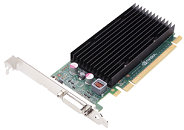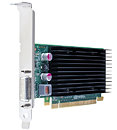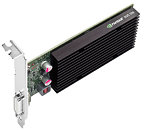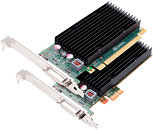Wednesday, December 1st 2010

NVIDIA Introduces NVS Business Graphics Solutions
NVIDIA announced today the immediate availability of the NVIDIA NVS 300 Business Graphics Solution, a graphics processor designed for the enterprise that delivers exceptional visual fidelity across up to eight displays while consuming minimal power. With nearly 25 percent more efficient power utilization, the NVS 300 graphics processor is designed for mission-critical applications ranging from command and control centers, to securities trading floors, to digital signage installations.
The NVS graphics processor brand has become the standard for multi-display business computing environments because it is easy to deploy, cost-effective and power efficient. The NVS 300 graphics processor simplifies IT administration, offering the most versatile display connectivity available in a low-profile, space saving graphics card design. Regardless of the display type (LCD, DLP or plasma) or system type (standard tower PC, workstation or small form factor system), the NVS 300 delivers the best image quality, supporting VGA, DVI, DisplayPort and HDMI at resolutions as high as 2560x1600.With built-in, new NVIDIA Mosaic technology, and NVIDIA nView Desktop Management Software that support single or multi-display environments, the NVS 300 graphics processor improves user productivity by enabling efficient management of the Windows desktop across multiple displays. NVIDIA Mosaic technology provides seamless taskbar spanning, as well as transparent scaling of any application across up to eight displays. NVIDIA Mosaic technology can be used to enable one or more NVS 300 cards to drive either many independent displays simultaneously, or one ultra-high resolution display.
"The NVS 300 is built for demanding enterprises that require high reliability, improved manageability, and tremendous value," said Jeff Brown, general manager, Professional Solutions Group, NVIDIA. "The ability to support legacy and current display types provides an upgrade path without disrupting existing, complex installations."
Built by NVIDIA to the Highest Standards of Quality
The NVS 300 graphics processor is designed, built and supported by NVIDIA to ensure reliable performance and maximum uptime for the most demanding operating environments. NVIDIA also offers dedicated customer support with personalized service for enterprise customers.
The NVS 300 graphics processor is EnergyStar compliant, and with its built-in power management technology, offers exceptional energy efficiency, intelligently adjusting power consumption based on the applications in use -- all without sacrificing performance. Its reliable, passive thermal design provides ultra quiet operation and increases the product's lifespan.
Availability and Pricing
The NVIDIA NVS 300 ($149 MSRP, USD) is available in PCI Express x16 and x1 configurations from major business PC and workstation OEMs, and from authorized distribution partners including: PNY Technologies in the Americas and Europe, ELSA in Japan, and Leadtek in Asia Pacific. For more information, visit the product page.
The NVS graphics processor brand has become the standard for multi-display business computing environments because it is easy to deploy, cost-effective and power efficient. The NVS 300 graphics processor simplifies IT administration, offering the most versatile display connectivity available in a low-profile, space saving graphics card design. Regardless of the display type (LCD, DLP or plasma) or system type (standard tower PC, workstation or small form factor system), the NVS 300 delivers the best image quality, supporting VGA, DVI, DisplayPort and HDMI at resolutions as high as 2560x1600.With built-in, new NVIDIA Mosaic technology, and NVIDIA nView Desktop Management Software that support single or multi-display environments, the NVS 300 graphics processor improves user productivity by enabling efficient management of the Windows desktop across multiple displays. NVIDIA Mosaic technology provides seamless taskbar spanning, as well as transparent scaling of any application across up to eight displays. NVIDIA Mosaic technology can be used to enable one or more NVS 300 cards to drive either many independent displays simultaneously, or one ultra-high resolution display.
"The NVS 300 is built for demanding enterprises that require high reliability, improved manageability, and tremendous value," said Jeff Brown, general manager, Professional Solutions Group, NVIDIA. "The ability to support legacy and current display types provides an upgrade path without disrupting existing, complex installations."
Built by NVIDIA to the Highest Standards of Quality
The NVS 300 graphics processor is designed, built and supported by NVIDIA to ensure reliable performance and maximum uptime for the most demanding operating environments. NVIDIA also offers dedicated customer support with personalized service for enterprise customers.
The NVS 300 graphics processor is EnergyStar compliant, and with its built-in power management technology, offers exceptional energy efficiency, intelligently adjusting power consumption based on the applications in use -- all without sacrificing performance. Its reliable, passive thermal design provides ultra quiet operation and increases the product's lifespan.
Availability and Pricing
The NVIDIA NVS 300 ($149 MSRP, USD) is available in PCI Express x16 and x1 configurations from major business PC and workstation OEMs, and from authorized distribution partners including: PNY Technologies in the Americas and Europe, ELSA in Japan, and Leadtek in Asia Pacific. For more information, visit the product page.




28 Comments on NVIDIA Introduces NVS Business Graphics Solutions
AMD allows multiple independent displays, or almost any configuration of it. So one card can support 6 displays, or 5 in the case of the card I linked. All hardware accelerated, with enough junk in the trunk to do it right.
Six 1080P projectors on a 30' wide screen, or six displays, or three, or four, but not five yet......replicate them all, or one large surface, or three surfaces.